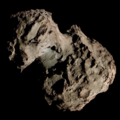 Comet 333P/LINEAR photographed by NEOWISE on 21 February 2016 | |
| Discovery [1] | |
|---|---|
| Discovery site | LINEAR |
| Discovery date | 4 November 2007 |
| Designations | |
| P/2007 VA85 | |
| Orbital characteristics [2] [3] | |
| Epoch | 21 November 2025 (JD 2461000.5) |
| Observation arc | 17.87 years |
| Number of observations | 1,340 |
| Aphelion | 7.329 AU |
| Perihelion | 1.113 AU |
| Semi-major axis | 4.222 AU |
| Eccentricity | 0.73629 |
| Orbital period | 8.674 years |
| Inclination | 132.02° |
| 115.71° | |
| Argument of periapsis | 26.033° |
| Mean anomaly | 40.531° |
| Last perihelion | 29 November 2024 |
| Next perihelion | 2033-Aug-01 [4] |
| TJupiter | 0.418 |
| Earth MOID | 0.176 AU |
| Jupiter MOID | 0.364 AU |
| Physical characteristics [5] | |
Mean radius | 3.04 km (1.89 mi) |
| 21.04 hours [6] | |
| (V–R) = 0.44±0.01 | |
| Comet total magnitude (M1) | 15.0 |
| 10.7 (2024 apparition) | |
333P/LINEAR is a Jupiter-family comet in an 8.7-year retrograde orbit around the Sun. Upon discovery, it was the object with the shortest known retrograde orbit. The comet was discovered by LINEAR on 4 November 2007. [1]



